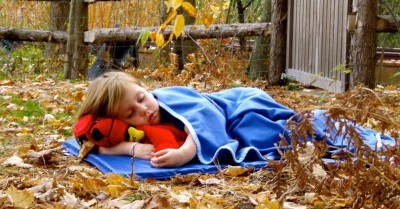In Norway and most other Scandinavian countries, children nap in the outdoors. According, to research outdoor sleeping not only promotes better daytime sleeping, but it also increases the duration of sleep. With Australia's serene climate, it's a great way for services to explore outdoor sleeping.
A Perth Childcare centre has implemented an Outdoor Sleeping policy and has seen positive results, including the children waking up more refreshed and rejuvenated, have improved cognitive awareness and alertness and sleep longer.
The children at the centre get cosy in the shade no matter the season, and close attention is paid to the day’s UV rating so sunscreen can be applied. If it’s windy or drizzling, tarps are used to keep the kids comfy.
The Benefits Of Outdoor Sleep Times For Children
- Natural light exposure - This resets the body clock and adjusts with circadian rhythms, and you produce more melatonin for a more restful sleep, unlike artificial light which interferes with sleep quality.
Increased immunity - Plants give off phytoncides to protect themselves which humans can benefit from lower blood pressure and other health boosters. - Better functioning of body and brain - Higher quality oxygen will improve the functioning of the brain and body for better productivity, mobility, recovery and more. Whereas stale inside air laden with carbon dioxide can lead to lethargy and a slower metabolism.
- Reduced stress - Just seeing trees has been proven to reduce stress levels, as has listened to the sounds of nature and the outdoors.
- Reduced illness - Air conditioning spreads germs and dries up children's sinuses, leaving them open to infection. One centre reported that over an 11-week period during winter (when colds and flu are usually rife), they only had a total of less than 1 per cent of absentees which they attribute to outdoor napping.
- Improved learning - As children sleep longer, deeper and more serenely when outside, they're more refreshed, rejuvenated and ready to learn when they wake. Their cognitive attentiveness, alertness and awareness are higher compared to napping indoors.
- Better physical and emotional development - Outside sleeping can increase children’s brain, bone and muscular development, along with their social and emotional wellbeing.
Numerous ongoing researchers from a wide variety of independent organisations have demonstrated the significant benefits of children spending extended periods of time outdoors in nature (including sleep).
Introducing Outdoor Sleep Times At Your Centre
- Find a suitable space - Depending on how many kids there are, you will probably need quite a large area. Under a large tree, grass or on a veranda are all good options.
- Ensure appropriate bedding - You may need more suitable beds and blankets or ask parents to supply sleeping bags. You will also need to ensure there is sufficient shade, so additional shade sails may be required or tarpaulins for light rain cover, and have children wear hats plus sunscreen.
- Determine your age group - Generally, the best age for outdoor naps is 2-5 years old. In a centre environment, it's best that babies are kept indoors within cots due to their individual sleep patterns.
- Communicate with parents - Give detailed materials to families regarding the new proposed sleeping arrangements, including all the research-backed benefits. Encourage questions and give them an opportunity to opt-out of the new policy as well.
- Adhere to safety guidelines - Just as you would with indoor sleeping, ensure your outdoor nap procedures follow the official regulations regarding sleep in early childhood settings - such as regular monitoring of temperature, breathing and length of sleep. Given the children are outdoors and not contained, it's imperative that they're supervised at all times too.
- Have a weather policy - In times of extreme weather, such as soaring temperatures, rain, sleet, heavy wind, dust storms and lightening, it's best to stay indoors for sleep.
- Be mindful of exceptions - If a child has recently been ill or doesn't want to sleep outside, then don't force them.
- Use common sense - To determine if it's appropriate for a child to be outside, especially when it's cold, and allow all children to have the option of sleeping indoors or out.
- Provide results and feedback - Put a strategy in place with your educators to record the results – both positive and negative – of outdoor naptime in your centre over an initial trial period, including looking at whether absences decreased for this time. Then provide a summary of results to parents and educators ahead of declaring it a permanent policy, to ensure it is in fact working for all.
Safe Sleep and Rest Practices
- Policies and procedures about children’s sleep and rest must be in place at all children's education and care services from October 2017.
- A quiet place should be designated for rest and sleep, away from interactive groups. If designated for rest, space should allow for a calm play experience.
- Children’s sleep and rest environments should be free from cigarette or tobacco smoke.
- Sleep and rest environments and equipment should be safe and free from hazards.
- Supervision planning and the placement of educators across a service should ensure educators are able to adequately supervise sleeping and resting children.
- Educators should closely monitor sleeping and resting children and the sleep and rest environments.
For those services wanting to take sleep times outdoors or even to trial it, it's imperative that all children should feel safe and educators have a duty of care to ensure children are provided with a high level of safety when sleeping and resting and every reasonable precaution is taken to protect them from harm and hazard.
References:
- Why You Should Consider Taking Children's Naptimes Outside, CareforKids NZ
- Why this childcare centre gets kids to sleep outside, Educational Central NZ
- Kids Sleeping Outside, Mamamia
- The Childcare Centre Letting Kids Nap Outside In All Weather, Mums Grapevine
- Safe Sleep and Rest Practices, ACECQA
